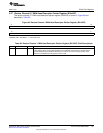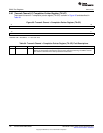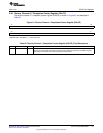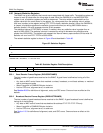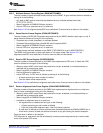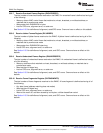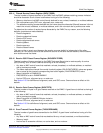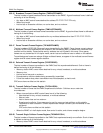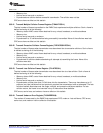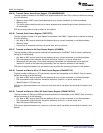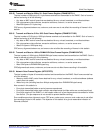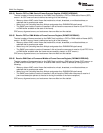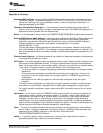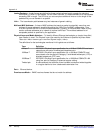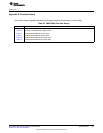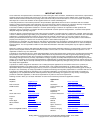
Appendix A
www.ti.com
Jumbo Packets— Jumbo frames are defined as those packets whose length exceeds the standard
Ethernet MTU, which is 1500 kbytes. For the C64x+ devices, it is recommended not to use packets
exceeding 35K in length. The PHY that you use can place additional limits on to the length of the
packets that you can transfer in a system.
Link— The transmission path between any two instances of generic cabling.
Multicast MAC Address— A class of MAC address that sends a packet to potentially more than one
recipient. A group address is specified by setting the LSB of the first MAC address byte. Thus,
01h-02h-03h-04h-05h-06h is a valid multicast address. Typically, an Ethernet MAC looks for only
certain multicast addresses on a network to reduce traffic load. The multicast address list of
acceptable packets is specified by the application.
Physical Layer and Media Notation— To identify different Ethernet technologies, a simple, three-field,
type notation is used. The Physical Layer type used by the Ethernet is specified by these fields:
<data rate in Mb/s><medium type><maximum segment length (×100m)>
The definitions for the technologies mentioned in this guide are as follows:
Term Definition
10Base-T IEEE 802.3 Physical Layer specification for a 10 Mb/s CSMA/CD local area
network over two pairs of twisted-pair telephone wire.
100Base-T IEEE 802.3 Physical Layer specification for a 100 Mb/s CSMA/CD local
area network over two pairs of Category 5 unshielded twisted-pair (UTP) or
shielded twisted-pair (STP) wire.
1000Base-T IEEE 802.3 Physical Layer specification for a 1000 Mb/s CSMA/CD LAN
using four pairs of Category 5 balanced copper cabling.
Twisted pair A cable element that consists of two insulated conductors twisted together
in a regular fashion to form a balanced transmission line.
Port— Ethernet device.
Promiscuous Mode— EMAC receives frames that do not match its address.
158
Glossary SPRUEF8F–March 2006–Revised November 2010
Submit Documentation Feedback
Copyright © 2006–2010, Texas Instruments Incorporated



